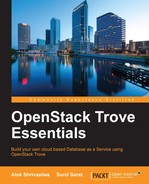Database management has come a long way over the last decade or so. The process of provisioning databases used to start with racking and stacking a physical server, installing and configuring an operating system, and finally, installing and configuring a database management system. This entire process took weeks and, in some cases, months. Once the database is provisioned, you then of course have a whole host of things to be managed, including availability, backups, security, and performance. This provisioning and management consumed a lot of time and resources. During the evolution, we had two trends that have had a significant impact on the way databases were provisioned and managed. Automation eased the management aspect and virtualization eased the provisioning, at least up to the operating-system layer. Meanwhile, the other trend that we have seen is that enterprises are moving away from a single database technology model to a model which is fancily termed "polyglot persistence". This basically means adopting multiple database technologies with the intention of storing the data in a database that is best suited for that type of data. With multiple types of database technologies coming into play, enterprises are finding it difficult to manage this complexity while maintaining corporate standards and compliance.
Fortunately for us, over the last couple of years, cloud is the other trend that came to our rescue. With the advent of cloud, we have initially seen self-service based agile provisioning of infrastructure take off, which has been termed as Infrastructure as a Service and has automated a lot of aspects and made infrastructure management easier. Building on this a bit more, we now have self-service based agile provisioning of multiple types of databases, which is popularly known as Database as a Service (DBaaS). This has made things much easier for enterprises in terms of bringing in efficiencies and enforcing corporate standards and compliance. Enterprises can avail DBaaS from a public cloud such as Amazon Web Services or Microsoft Azure. Alternatively, they can build their own private cloud-based DBaaS and the need for this could be owing to various reasons such as data privacy and security. This is where OpenStack and Trove comes into the picture. OpenStack Trove is an open source implementation of DBaaS. While it has been in existence for a couple of years, it has started gaining momentum only recently with enterprises giving it a serious thought.
The benefits of DBaaS in general and OpenStack Trove in particular are obvious. The key challenge, however, is that beyond the documentation that is available from the OpenStack project itself, there is not much reading material out there to help potential DBAs and system/cloud administrators. This lack of skill and know-how is one of the potential inhibitors to OpenStack Trove adoption.
This book is an attempt to provide all the essential information that is necessary to kick-start your learning of OpenStack Trove and set up your own cloud-based DBaaS. In this book, the readers will be introduced to all major components of OpenStack Trove. Following this, the readers will get to understand how to set up Trove in both development and production environments, configuring it, and performing management activities such as backup and restore. Not to mention, it also deals with certain advanced database features, such as replication and clustering. This book takes a more practical approach to learning, as the learning from each chapter will contribute to the reader's ability to build his/her own private cloud-based DBaaS by the time he/she completes reading this book. We hope you will enjoy reading this book and, more importantly, find it useful in your journey towards learning and implementing DBaaS using OpenStack Trove.
Chapter 1, Introducing OpenStack Trove, introduces the concept of Database as a Service and its advantages, followed by a quick introduction to the OpenStack Trove project and its components.
Chapter 2, Setting up Trove with DevStack in a Box, provides a list of prerequisites for the book. This chapter also helps you understand DevStack and its components and then helps you set up Trove with DevStack.
Chapter 3, Installing Trove in an Existing OpenStack Environment, gives you an overview of the different available methods to deploy Trove. It deals a little bit more in detail with installing Trove from source and the Ubuntu repository.
Chapter 4, Preparing the Guest Images, as the name implies, details how to build production-ready images that will be required by Trove.
Chapter 5, Provisioning Database Instances, looks at creating and launching instances using both CLI and GUI.
Chapter 6, Configuring the Trove Instances, introduces you to configuring Trove instances and also how to make configuration changes to multiple Trove instances using configuration groups.
Chapter 7, Database Backup and Restore, introduces the concept of Strategies and provides an overview of how to back up and restore Trove instances.
Chapter 8, Advanced Database Features, deals with advanced features such as replication and clustering in Trove.
